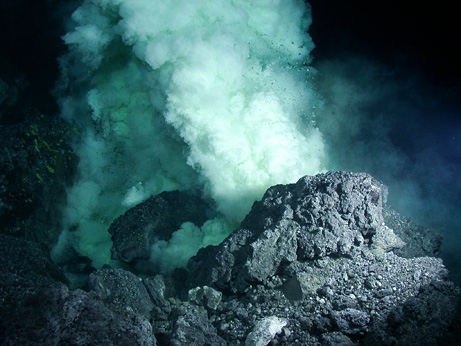Could a volcano devastate Andersen Air Force Base, Guam, in the same manner Clark Air Base, Philippines, was destroyed by Mount Pinatubo in 1991?
That is the question a joint team from the U.S. Geological Survey (USGS) and Southern Methodist University (SMU) is tackling in a two-year, $250,000 project designed to improve early warning monitoring of seismic events in the Northern Mariana Islands near Guam. The project involves the installation of new infrasound devices alongside traditional volcano monitoring equipment, such as seismometers and global positioning systems.
The volcano research will aid U.S. troop safety, said Margaret Allen, senior research writer at SMU. “Technology used to detect nuclear explosions and enforce the world’s nuclear test ban treaty now will be pioneered to monitor active volcanoes in the Northern Mariana Islands near Guam,” she said.
Guam has increasingly become an important strategic chess piece in the Asia-Pacific as the island becomes the primary base for forward deployment of U.S. military forces in the region.
The chief of the volcano project, James Quick, was in the Northern Marianas in March to oversee the installation of the infrasound equipment on three of the 15 Mariana Islands. Nine islands have active volcanoes, he said, and on average the archipelago experiences about one eruption every five years.
Quick, now with SMU, served previously as the program coordinator of the USGS Volcano Hazards Program. “Compared to Clark Air Base, … the threats are less direct to military deployment in Guam and the Marianas,” he said.
A volcanic eruption on Guam itself appears unlikely, said Mark Reagan, professor of igneous petrology and geochemistry at the University of Iowa.
“Our best age information places the last volcanism on Guam itself in the Miocene [epoch], and probably more than 10 million years ago,” he said. “This and Guam’s position significantly east of the submarine volcanoes related to modern subduction” makes the chance of an eruption on Guam remote.
However, volcanically generated tsunamis and airport closure because of ash fall are still possibilities. Ash from the 2005 eruption of the Anatahan volcano, 200 miles north of Guam, closed the Guam airport.
Quick sees less chance of a problem for Andersen, which is “farther from active volcanoes.” The principal threats posed to U.S. military operations are to “in-flight aviation operating out of Guam and/or in the vicinity of the Marianas, and to military exercises that may be conducted on or near the volcanic islands.”
Pagan Island, with two active volcanoes, has been identified as an ideal location to practice beach landings. Also, live-fire exercises are being conducted on the Farallon de Medinilla Island near Anatahan.
References:
http://www.marinecorpstimes.com/news/2010/04/040510_guam_volcano_web/




